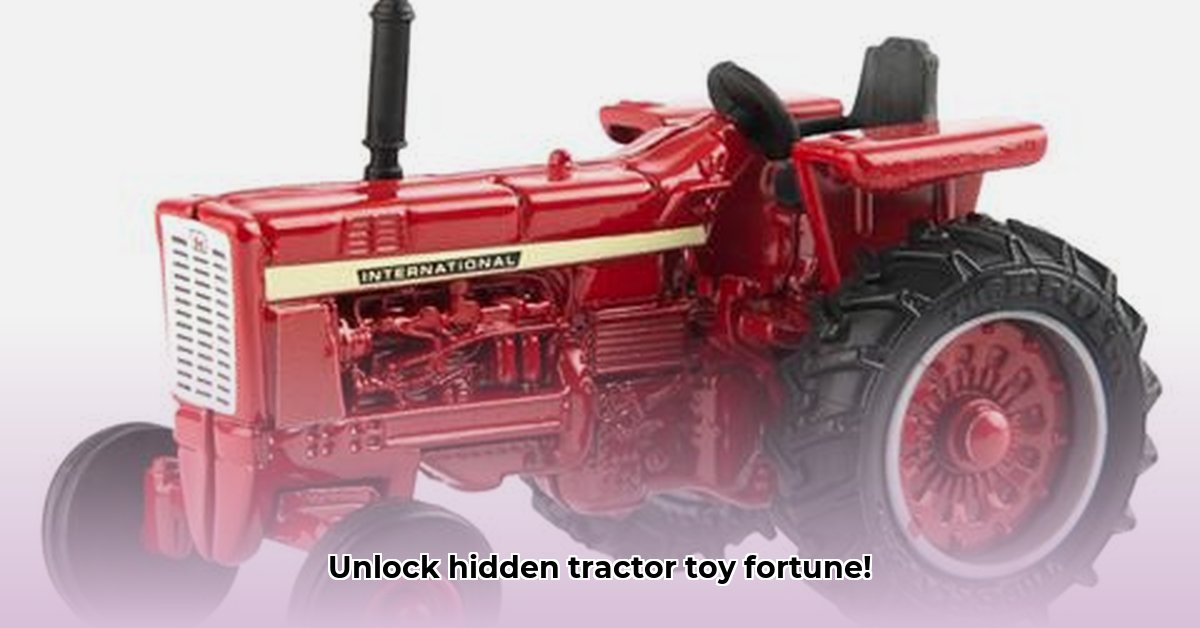
Finding a dusty old toy tractor in your attic might seem unremarkable, but it could be the start of a fun and potentially profitable hobby! Collecting vintage toy tractors isn't just about nostalgia; these miniature machines can hold surprising value. This guide will help you navigate this exciting world, from identifying hidden gems to caring for your collection and even selling it down the line. For example, check out this site on vintage Oliver tractors for more information. Let's get started!
Identifying Valuable Vintage Toy Tractors: The Treasure Hunt Begins
This section focuses on how to spot a potential prize among your old toy tractors. Several key factors influence a tractor's value, transforming a simple toy into a valuable collectible. Did you know that some rare toy tractors can fetch surprisingly high prices? Let's explore what makes them valuable.
Brand Recognition: Established names like Ertl, Hubley, and Tonka often command higher prices. Collectors gravitate toward these recognizable brands, associating them with quality and nostalgia. However, don't overlook lesser-known brands; rarity can significantly boost a tractor's worth.
Model Year and Specific Models: Older tractors, especially those from the pre-war era (1920s-1930s), are typically more valuable due to their age and rarity. Certain models, like the iconic Fordson Model F, hold particular appeal among collectors.
Features & Details: Highly detailed models are more desirable. Look for realistic tires, intricate features, authentic paint jobs, and working parts (like a moving plow or tilting bucket). The more realistic and well-made it is, the more valuable it may be.
Condition: The condition of your tractor is paramount. A pristine tractor, still in its original box, is the holy grail. Scratches, dents, faded paint, and missing parts dramatically impact value.
Rarity: Limited-edition tractors or those produced in smaller quantities are usually worth more. The lower the number produced, the higher the potential value.
Accessories: The original box, any manuals, or extra accessories significantly add to a tractor's worth. These extras provide provenance and are often much-sought-after by serious collectors.
Assessing Condition and Value: A Step-by-Step Approach
Now you know what to look for; let's learn how to assess condition methodically. While subjective, a structured approach helps determine a tractor's worth. Remember, condition is a major factor in determining value!
Visual Inspection: Carefully examine the paint. Look for chips, scratches, or fading. Is the paint even and well-applied? Check decals for peeling or damage. (High-quality paint and intact decals significantly increase value.)
Moving Parts Check: Test wheels, levers, and other moving parts. Do they function smoothly? Are they loose, broken, or stuck? (Working mechanisms add to a tractor's desirability.)
Overall Wear and Tear: Look for dents, bends, or cracks. Consider the overall level of wear. A lightly played-with tractor will be worth more than one showing heavy use. (Heavy wear and tear will drastically reduce value.)
The Box Factor: Is the tractor in its original packaging? Is the box in good shape? An original, undamaged box drastically impacts value. (An original box can double or even triple a tractor’s value.)
Comparison Shopping (with Caution): Use online resources and price guides to compare similar tractors but remember prices vary. Use this as a general guide, not a precise valuation tool. (Online research should be used cautiously, comparing many examples to get a general idea.)
Finding and Buying Vintage Tractors: Where the Hunt Takes Place
The thrill of the hunt is half the fun! Here's where you can find these treasures and how to navigate online purchases safely. Did you know that unexpected bargains often lie in the most unexpected places?
Online Marketplaces (eBay, etc.): These are excellent starting points, but always research sellers thoroughly before buying. (Check seller ratings and read reviews carefully.)
Antique Shops and Flea Markets: These are goldmines for unexpected discoveries. You might stumble upon hidden gems amidst other forgotten treasures.
Auctions: Auctions can offer unique opportunities, but competition can be fierce. Do your research and set a maximum bidding price. (Research thoroughly and set a budget before bidding.)
Safe Online Buying Strategies:
Check Seller Reviews: Always check seller reviews and feedback ratings before committing to a purchase. (High seller ratings indicate reliability.)
Escrow for Protection: Consider using an escrow service; this protects both buyer and seller. (Escrow services add extra security to transactions.)
Ask Questions: Don't hesitate to ask the seller for additional photos or details about the tractor's condition. (A responsive seller is a good sign.)
Caring for and Displaying Your Collection: Protecting Your Investment
Proper care maintains value and extends your tractor's lifespan. How well you care for your collection directly impacts its value.
Gentle Cleaning: Use a soft cloth and mild soap and water to gently remove dust and dirt. Avoid harsh chemicals or abrasive cleaners.
Smart Storage: Store your tractors in a cool, dry place, away from direct sunlight and extreme temperatures. This prevents fading, warping, and damage.
Showcase Your Finds: Use display cases, shadow boxes, or shelves to show off your collection while protecting it from dust and damage. (Proper display helps maintain value and enhances enjoyment.)
Selling Your Vintage Tractors (Optional): Turning Your Collection into Cash
If you decide to sell, high-quality photos and detailed descriptions are crucial for attracting buyers. Remember, accurate assessment of value—established in earlier steps—enables you to set a competitive price. Here's how to maximize your return:
Professional Photos: Showcase your tractors in the best possible light, highlighting key features and details. (High-quality images are essential for attracting potential buyers.)
Descriptive Detail: Write a detailed and accurate description, focusing on model, brand, condition, and accessories. Be honest and transparent about imperfections. (Detailed descriptions are crucial for transparent sales.)
Strategic Pricing: Research similar tractors to determine a competitive yet fair price. Consider starting slightly higher than your desired price; you can always lower it later. (Pricing research minimizes risks and maximizes profitability.)